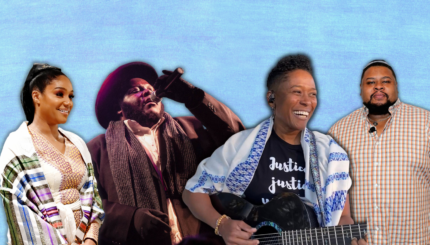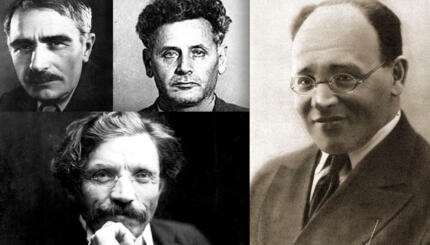Reprinted with permission from A History of Jews in America, published by Vintage Books.
For those of vested social ideologies, a popular audience was less important than editorial control. Beginning in 1940, Norman Cousins, another Jewish immigrants’ son, edited the liberally oriented Saturday Review of Literature. Philip Rahv continued to direct the affairs of the feisty little Partisan Review, the journal for leftist academic literary criticism, with Midge Decter as associate editor. Irving Kristol, Daniel Bell, Nathan Glazer, and Seymour Martin Lipset edited The Public Interest, favoring a discreet political centrism.
Dissent, the most unequivocally political of these intellectual journals, strove to keep alive the anti-Stalinist socialism of its founding editor, Irving Howe. Elliott Cohen launched Commentary for the American Jewish Committee, and Norman Podhoretz (the husband of Midge Decter) later became Cohen’s successor there.
The New York Review of Books, founded and edited in 1963 by Robert Silvers and Barbara Epstein as the American equivalent of Britain’s Times Literary Supplement, may have been the most influential of these popular “intellectual” publications. It was assuredly the most eclectic, with articles ranging from literature, art, and music to science, economics, philosophy, theology, and history. By the mid-1980s, the Review’s circulation of 100,000 was far wider than that of its peers. Undisguisedly leftist in its editorial bias, the publication included as its nucleus of contributors the same comminuted group of New York Jews that had sustained the early Partisan Review, among them Philip Rahv, Irving Howe, Irving Kristol, and Midge Decter.

Help us keep Jewish knowledge accessible to millions of people around the world.
Your donation to My Jewish Learning fuels endless journeys of Jewish discovery. With your help, My Jewish Learning can continue to provide nonstop opportunities for learning, connection and growth.
Origins
By and large, these were people who shared a second-generation background. They had grown up together, attended the same New York schools (the “College of Irvings,” a wag suggested), fought the same youthful left-of-center battles. Most of them had nurtured literary or artistic ambitions, which in the Depression years went unrequited. The turning point in their careers was the late 1940sand early 1950s. Postwar prosperity, diminishing anti-Semitism, the rapid expansion of higher education, and audience interest in intellectual ideas all played a role. Their talent found well-paying new outlets, too, in Commentary, The New Yorker, The New York Times, even Fortune. They were winning Guggenheim and Fulbright grants, and appointments to universities. Academically based at last, figures like Alfred Kazin, Irving Kristol, Irving Howe, Daniel Bell, and Leslie Fiedler now enjoyed a certain leisure for their creativity. In ensuing years, few critics could match them in either prodigality or originality.
Clement Greenberg, art critic for the Nation and a perennial contributor to Partisan Review, and Harold Rosenberg, a lawyer-turned-art-critic, led the break from formalism by championing the works of Jackson Pollock and Willem De Kooning, selling the abstractionist tendency in art as the “New American Style.” Not coincidentally, these critics rose to eminence in the 1950s,when an affluent new group of art buyers emerged, uninhibited by traditional canons of taste. Jewish critics–and Jewish art dealers–accordingly were able to reassure these nouveaux-riches that abstract canvases were the wave of the artistic future.
Literary Criticism
Yet the impact of the New York intellectuals possibly was even more far-reaching in literary criticism than in art. Lionel Trilling was the first among them to make his mark. Once having surmounted the anti-Jewish barrier in the 1930sto win appointment to Columbia’s English department, Trilling rose swiftly to full professor, even, in 1970, to University Professor. A brilliant teacher, he became a major influence on a new generation of Jewish intellectual gymnasts who now enlivened Columbia as if there had never been a Nicholas Murray Butler [president of Columbia University during the first half of the 20th century] and a numerus clausus [quota restricting Jewish faculty].
In 1942, meanwhile, while still in his twenties, Alfred Kazin published his epic On Native Grounds, a panorama of American literature from the late 18th century to his own time. Received with immediate acclaim, the volume was a rediscovery of America through the alembic of its literature. Nothing of its scope or acuity had yet appeared, and Kazin swiftly took over from Van Wyck Brooks a precocious “deanship” of American literary criticism.
During the postwar years, as literary editor of the New Republic and professor at City College and Amherst, Kazin turned to a series of creative reminiscences. In three volumes, A Walker in the City (1951), Starting Out in the Thirties (1965), and New York Jew (1978), his autobiographical odyssey functioned as a nonfiction version of the acculturation novels then in vogue among second-generation Jewish writers. In essence, the work served as a proclamation that a son of immigrant Jews was fully as capable as were Old Americans of mastering the Volkswesen (as cultural snobs had described the “national essence” in kaiserian Germany). It was precisely the Jew’s full-hearted immersion in two cultures, insisted Kazin, that gave him the perspective of objectivity.
Western Member of the N.Y. Intelligentsia
Leslie Fiedler worked no less assiduously than Kazin to fulfill that synergetic role. Educated at New York University and Columbia, a conventional Jewish leftist in his teens, Fiedler was an unlikely candidate for a major academic appointment. Until the 1960s, he taught at Montana State University. Yet even in the West, his unofficial membership in the New York intelligentsia did not lapse. Somehow he managed to overcome his lack of research facilities to produce a torrent of scintillating articles, novels, and books of criticism on almost every phase of American literature.
In sheer versatility, however, Irving Howe–from the 1950s on–transcended Fiedler, Kazin, and virtually all of his contemporaries as both literary critic and social historian. A product of the Bronx and Brooklyn College, Howe began his career in the 1940s as a newspaper critic and English instructor at Hunter College.
Typically, he also devoted a major part of his creativity to leftist themes. Although he had long since shed his Depression-era Trotskyism, in 1954 he founded and edited the mildly Socialist Dissent. Beyond his editorial vocation and political activism, meanwhile, Howe produced a series of truly distinguished literary biographies–of Sherwood Anderson, William Faulkner, Thomas Hardy, even Leon Trotsky. By the 1970s, his literary essays and reviews almost invariably were awarded front-page prominence by The New York Times Book Review, the New York Review of Books, and other major literary forums.
Alienation
In their passionate ideological commitments and bristling tendentiousness, the New York intellectuals often appeared to validate John Murray Cuddihy’s theory that Jewish intellectuals felt peculiarly afflicted by the “ordeal of civility.” “[They] contained something faintly alien to our native roots and native habits,” admitted Mary McCarthy, an intermittent participant in the group. Yet that “alienation,” a historic Jewish critical stance long recognizable in European culture, manifestly imbued the Jewish component with its avant-gardist effervescence.
Arguably, the New Yorkers left no distinct social or literary “school” behind. Unlike Hannah Arendt and other refugees who had studied with the great minds and had been exposed to the intellectual “systems” of Central Europe, the New Yorkers were eclectic. They had learned to extemporize on their feet at City College or Brooklyn College. In their time, nevertheless, these immigrant sons and daughters completed the process of deprovincializing American culture. Bored by the apparent parochialism of native American criticism, they re-evaluated American art and literature with a ferocious iconoclasm and a consciously skewed angle of vision that would leave the Volkswesen forever changed.


